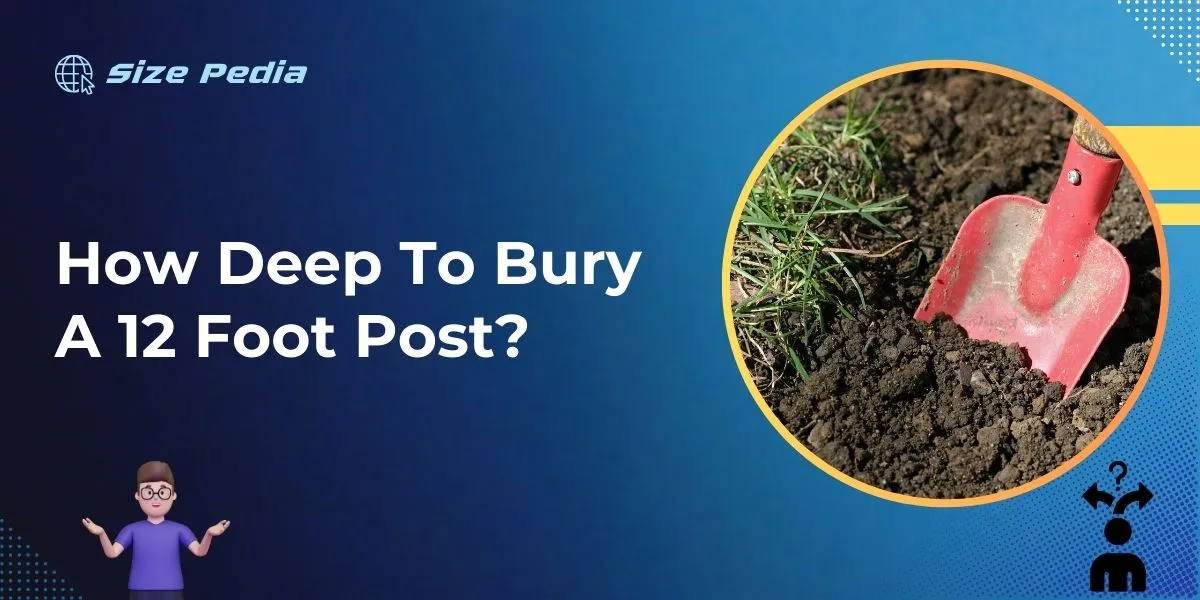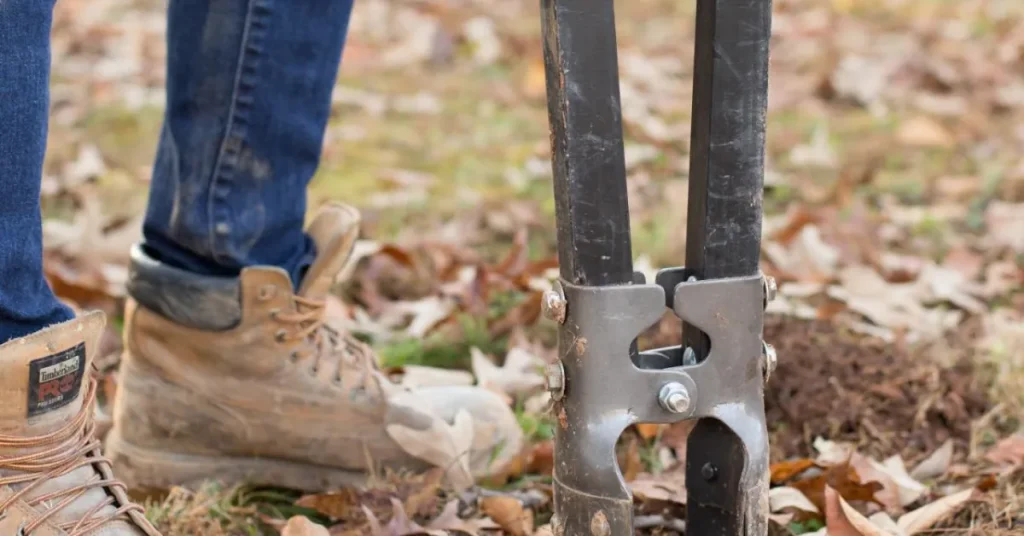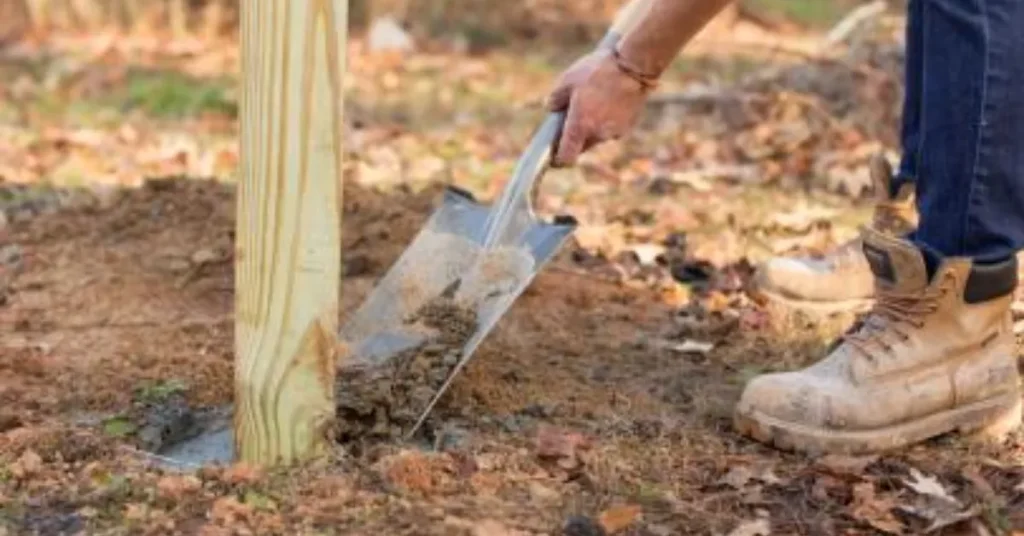Bury a 12-foot post at least 3 feet deep to ensure stability and to meet standard building codes. Make sure the hole is wide enough to accommodate concrete for proper anchoring.
Establishing strong, stable, and secure construction projects often begins with setting posts in the ground properly. Whether you’re building a fence, a deck, or a pergola, the depth at which you bury a post is critical for the structure’s longevity and safety.
Knowing the right depth for the specific length of the post can save you from future hassles. A general rule for outdoor structures is to bury one-third of the post’s total length into the ground.
This benchmark helps resist the forces of wind and weather. Moreover, the deep burial provides a robust foundation to prevent leaning and uprooting over time.
This standard applies to a variety of post materials, including wood, metal, and vinyl. Always remember, adhering to local building codes and considering soil type are crucial steps in the installation process.

Choosing The Right Depth For Your 12-foot Post
Choosing the right depth for your 12-foot post is vital for stability and durability. The deeper you bury your post, the stronger it will stand.
But, this doesn’t mean you should dig to the center of the Earth. Finding the perfect balance is key. It ensures your structure can withstand the elements and remain upright for years to come.
Factors Influencing Post Burial Depth
- Soil Type: Sandy soils require deeper posts than clay soils.
- Climate: Frost lines affect how deep you should bury the post.
- Structure Weight: Heavy structures need deeper support.
- Wind Exposure: Areas with high winds need deeper post settings.
- Building Codes: Local regulations may dictate minimum depth requirements.
Typical Depth Standards For Various Structures
| Type of Structure | Recommended Depth |
| Fences | 1/3 the height of the post (e.g., 4 feet deep for a 12-foot post) |
| Decks | At least 2 feet |
| Light Poles | 1/3 to 1/2 the height of the pole |
| Mailboxes | 1-2 feet |
Pre-installation Considerations
Before you begin the task of burying a 12-foot post, take a moment to consider key factors. These factors ensure your posts stand firm for years. So, let’s dive into the pre-installation considerations that every builder should assess.
Soil Type And Texture Analysis
Knowing your soil type is crucial. It determines the stability and longevity of your installation. Here’s a quick guide:
- Clay soil: Dense and retains moisture, requiring deeper installation.
- Sandy soil: Drains quickly but lacks stability, so it requires extra depth.
- Loamy soil: Ideal balance, supports posts well.
Conduct a simple test by moistening the soil and rolling it between your fingers. This helps to understand its texture and composition.
Climate Impact On Post Stability
Weather patterns play a pivotal role in post stability. Let’s break this down:
| Climate Condition | Effect on Post Stability | Recommended Action |
| Frequent rain | Increased moisture content. | Bury deeper and use water-resistant treatments. |
| Extreme cold | Potential frost heave. | Extend below the frost line to prevent shifting. |
| High winds | Posts may tilt or bend. | Enhance depth and reinforce with concrete. |
Assess your local climate history to make well-informed decisions. This helps you mitigate future problems that could compromise post stability.
Digging Techniques And Equipment

Proper Techniques and Equipment Needed to Bury a 12 Foot Post
You want a sturdy build. Knowing how deep to bury your post is crucial. Digging a hole for a 12-foot post can be intense.
Important factors include depth, width, and soil type. Using the right techniques and equipment ensures stability and durability. Let us dive into manual digging versus machinery, and safety measures.
Manual Digging Vs Machinery Use
- Manual Digging: A simple shovel can start the process. For deeper holes, use a post-hole digger. This tool grabs and removes soil clearly and efficiently. It’s great for tight spaces. Manual digging allows for precise control. But this method can be tiring and time-consuming.
- Machinery Use: For fast and easy digging, consider a power auger. Many stores rent this equipment. An auger drills deep into the earth quickly. It’s ideal for multiple posts. Remember to handle machinery with care. Improper use can damage your yard.
Safety Measures During Excavation
Before you dig, check for underground utilities. Call the local service. They will mark where it is safe to dig. This step stops accidents. Always wear safety gear:
- Protective gloves
- Steel-toe boots
- Hard hats if using heavy machinery
Follow the tool manufacturer’s instructions. Watch for signs of fatigue. Take breaks when needed. Drinking water is key. It helps to prevent overheating and exhaustion.
Securing The Post: Tips And Tricks
Installing a 12-foot post requires care and precision to ensure it stands strong for years to come. Correct burial depth is crucial, but so is how you secure the post in place. Let’s explore some tried-and-true methods.
Using Concrete For Added Stability
Concrete acts like an anchor, offering unbeatable firmness to your posts. Here’s how to use it effectively:
- Dig the hole to the right depth – approximately 1/3 to 1/2 of your post’s height.
- Place the post in the center of the hole.
- Mix the concrete following manufacturer’s directions.
- Pour the concrete around the post, to at least a few inches above ground level.
- Level the post and let the concrete set as per guidelines.
Quick tip: Slope the top of the concrete away from the post to help water run off and prevent rot.
Alternative Anchoring Methods
Concrete isn’t the only way to secure a post. Check out these alternative methods:
- Gravel can be used for drainage, filling the hole around the post.
- Post spikes provide a metal base that’s driven into the ground.
- Anchor plates can be fastened to the post bottom before burial.
| Material | Method | Best Use |
| Gravel | Bury with post for drainage | Wet areas |
| Spikes | Drive into ground | Temporary structures |
| Plates | Attach and bury | Decks, fences |
Remember to check local building codes as they might dictate the method to use.
Maintenance And Lifespan Of Buried Posts

Maintenance and Lifespan of Buried Posts are crucial for ensuring the stability and durability of any structure supported by them.
Proper care extends the life of your posts and delays costly replacements. Whether for a fence, a deck, or a mailbox, understanding the right upkeep is key.
Regular Inspection And Post Care
Buried wooden posts need routine checks to guard against rot and insects. Follow these steps:
- Inspect the post for signs of weakness every season.
- Check the ground moisture level.
- Ensure proper drainage around the post to avoid water buildup.
- Apply a wood preservative annually to prevent decay.
Consistent maintenance not only preserves the wood but also maintains its appearance.
When To Replace Your Wooden Post
Eventually, even well-maintained posts need replacement. Look for these signs:
| Replacement Sign | Action Needed |
| Severe Rot or Insect Damage | Replace immediately to prevent structural failure. |
| Cracks or Splits | Evaluate the depth. Deep cracks mean it’s time to replace. |
| Leaning or Instability | Assess the base. If compromised, replacement is necessary. |
Act swiftly on these issues to ensure safety and stability.
FAQs About How Deep To Bury A 12 Foot Post
How Deep Should A 12-foot Post Be Buried?
For a 12-foot post, it is recommended to bury at least one-third of the post’s length. This means the post should be buried 4 feet deep to ensure stability and support, considering various soil types and load requirements.
What Factors Affect The Depth For Burying Posts?
Factors that affect post burial depth include soil type, post height, load-bearing requirements, and climate conditions such as frost lines. Consulting local building codes can provide specific guidelines for your area.
Can You Anchor A Post Without Concrete?
Yes, you can anchor a post without concrete using alternative methods such as metal post anchors or gravel. These methods may vary in stability and are generally suited for lighter structures.
How Does Climate Influence Post Installation Depth?
Climate affects post installation depth primarily through the frost line. Posts must be set below this line to prevent heaving from freeze-thaw cycles. In areas with harsh winters, this may require deeper installation than in milder climates.
Conclusion
Securing a 12-foot post requires attention to depth for stability and longevity. Aim for a minimum of one-third the post’s height in the ground.
Remember, local conditions and building codes matter. Keep it steadfast by setting posts deep enough; your structure depends on it.
For enduring support, dig deep!
Resources:
1. https://www.fema.gov/case-study/overhead-underground-it-pays-bury-power-lines
